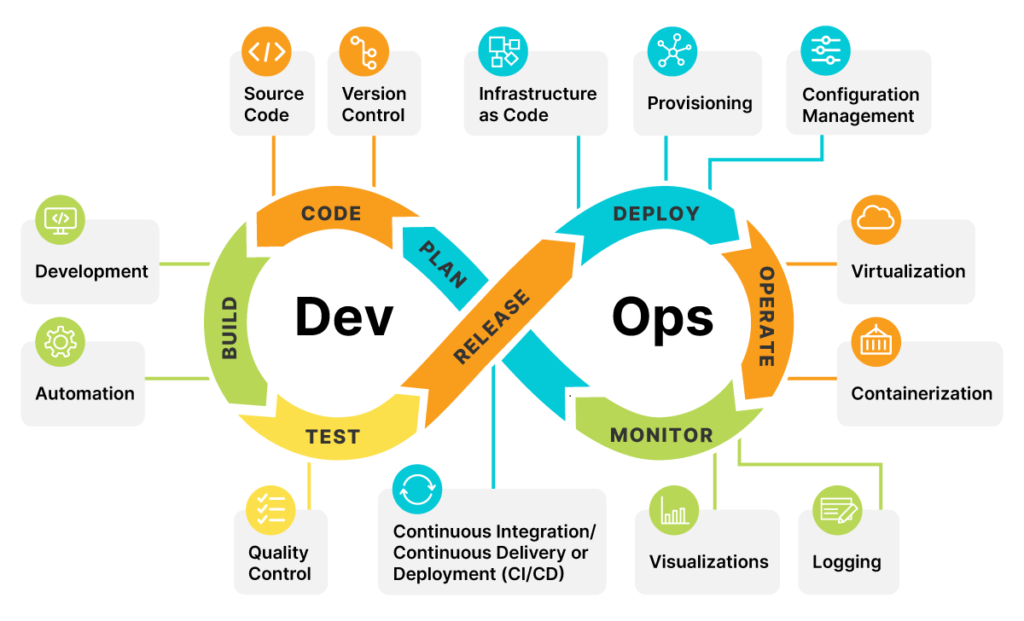With the best DevOps Model practices, webmasters have a set of flexible services designed to enable companies to more rapidly and reliably build and deliver products. These services simplify provisioning and managing infrastructure, deploying application code, automating software release processes, and monitoring your application and infrastructure performance.
DevOps is the combination of cultural philosophies, practices, and tools that increases an organization’s ability to deliver applications and services at high velocity. Whilst, evolving and improving products at a faster pace than organizations using traditional software development and infrastructure management processes. This speed enables organizations to do better.
Such as to serve their customers and compete more effectively in the market. Whilst, bearing in mind, that there are a few key practices that help organizations innovate faster. More so, through automating and streamlining the software development and infrastructure management processes. As you’ll learn, most of these practices are accomplished with proper tooling.
Under a DevOps model, web development and operations teams are no longer “siloed.” Sometimes, the teams are merged into a single unit where the engineers work across the entire app lifecycle. From development and testing to deployment to operations — developing a range of skills not limited to a single function. That said, let’s learn the general DevOps meaning.
The General DevOps Meaning In Applications Development Operations
To begin with, developers and system administrators are two essential departments that businesses need to work in tandem. So as to ensure the smooth functioning of the organization. Secondly, the demand from any business will include new features, services, and revenue streams — that can be added at a rapid pace. All this has to be executed on a reliable infrastructure.
Developers can send out new software all the time, but its implementation, handled by the operations department, often cannot be rapid-fire for the sake of stability. And this is where developers and operations tend to be at odds. In simple terms, DevOps, — a combination of development and operations — is a mix of design practices, dev tools, and cultural philosophies.
Overall, that enables an organization to quickly deliver applications and services. It also helps products go from the drawing board to market at a faster pace than traditional software development because operations and development engineers work closely together in the entire lifecycle, from design through the development process to production support.
In fact, operations/developers staff often use many of the same tools in tandem making the work go much smoother and faster. In other words, DevOps encompasses the culture and people within an organization, aiming to improve collaboration between the development team and operations. The merging of the two terms powers up the two disparate teams.
What Is The Significance Of DevOps In Applications Development?
Just as we’ve mentioned, the merging of the two terms is representative of the merging of work of these two previously disparate teams. “Dev” in DevOps refers to developers in particular, but it also means everyone involved in developing the software including QA, Product teams, etc. “Ops” refers to the systems engineers, system administrators, operations staff, etc.
As well as the release engineers, DBAs, network engineers, security professionals, and other subdisciplines and job titles. Ops are those that generally are charged with the deployment of the software that the developers created. Before DevOps, the two teams worked in very separate environments, one waiting for the other to complete their task.
Now, with DevOps, the two teams work more in tandem, catching any flaws and being more agile in changing design direction. The merging of the two terms is representative of the merging of the work of these two previously disparate teams. “Dev” in DevOps refers to developers in particular, but it also means everyone involved in the process like QA, Product teams, etc.
“Ops” refers to the systems engineers, system administrators, operations staff, release engineers, DBAs, network engineers, security professionals, and other subdisciplines and job titles. Ops are those that generally are charged with key tasks.
Such as the deployment of the software that the developers created. Before DevOps, the two teams worked in very separate environments, one waiting for the other to complete their task. Now, with DevOps, the two teams work more in tandem, catching any flaws and being more agile in changing design direction.
Understanding How A DevOps Model Powers Up Applications
To enumerate, the DevOps Model is a combination of cultural philosophies, practices, and tools that increases an organization’s ability to deliver apps and services at high velocity. While, at the same time, evolving and improving products at a faster pace — than organizations using traditional software development and infrastructure management models.
This speed enables businesses to better serve their customers and compete more effectively in the market. In some models, quality assurance and security teams may also become more tightly integrated with development and operations throughout the application lifecycle. When DevOps security is the focus of all, this is sometimes referred to as DevSecOps.
These teams use practices to automate processes that historically have been manual and slow. Using a technology stack and toolings, they can evolve applications quickly and reliably. Perse, these tools also help engineers independently accomplish various tasks. For example, things like deploying the applications code or provisioning services infrastructure.
Typically, this is what would have required help from other teams, thus it further increases a team’s velocity. What’s more, as you’ll learn later on, each service is scoped to a single purpose. Like, you can use different frameworks or programming languages to write microservices. And then, deploy them independently, as a single service, or as a group of services.
Why A DevOps Model Matters Plus Key Apps Development Benefits
The Internet and Software Tools have transformed various industries, from shopping to entertainment to banking. Software no longer merely supports a business; rather it becomes an integral component of every part of a business. Companies interact with their customers through software delivered as online services or applications and on all sorts of devices.
They also use software to increase operational efficiencies by transforming every part of the value chain, such as logistics, communications, and operations. In a similar way that physical goods companies transformed how they design, build, and deliver products using industrial automation throughout the 20th century, companies in today’s world must transform.
Especially, in terms of how they build and deliver software. One significant benefit of a strategic DevOps Model is security. To move quickly while retaining control and preserving compliance. You can adopt a DevOps Model without sacrificing security by using automated compliance policies, fine-grained controls, and configuration management techniques.
Organizations might also use a DevOps Model based on a microservices architecture to make their applications more flexible and enable quicker innovation. For example, using infrastructure as code and policy as code, you can define and then track compliance at scale. With that in mind, there are a few benefits that are associated with great DevOps integration.
1. Optimal Speed
Move at a high velocity so you can innovate for customers faster, adapt to changing markets better, and grow more efficiently at driving business results. The DevOps model enables your developers and operations teams to achieve these results. For example, microservices and continuous delivery let teams take ownership of services and then release updates quickly.
2. Rapid Delivery
Increase the frequency and pace of releases so you can innovate and improve your product faster. The quicker you can release new features and fix bugs, the faster you can respond to your customers’ needs and build a competitive advantage. Continuous integration and delivery are practices that automate the software release process, from build to deployment.
3. Uptime Reliability
Ensure the quality of application updates and infrastructure changes so you can reliably deliver at a more rapid pace while maintaining a positive experience for end users. Use practices like continuous integration and continuous delivery to test that each change is functional and safe. Monitoring and logging practices help you stay informed of performance in real time.
4. Performance Upgrade
Operate and manage your infrastructure and development processes at scale. Automation and consistency help you manage complex or changing systems efficiently and with reduced risk. For example, infrastructure as code helps you manage your development, testing, and production environments in a repeatable and more efficient manner.
5. Improved Collaboration
Build more effective teams under a DevOps cultural model, which emphasizes values such as ownership and accountability. Developers and operations teams collaborate closely, share many responsibilities, and combine their workflows. This reduces inefficiencies and saves time (e.g. reduced handover periods between developers and operations, writing code that takes into account the environment in which it is run).
How To Adopt A Working DevOps Model With The Top Best Practices
Transitioning to DevOps requires a change in culture and mindset. At its simplest, DevOps is about removing the barriers between two traditionally siloed teams, development, and operations. In some organizations, there may not even be separate development and operations teams; engineers may do both. With DevOps, the two teams work together to optimize results.
In this case, both the productivity of developers and the reliability of operations. On one hand, they strive to communicate frequently, increase efficiencies, and improve the quality of services they provide to customers. While, on the other hand, they take full ownership of their services, often beyond where their stated roles or titles have traditionally been scoped.
Specifically, they can think more about the end customer’s needs and how they can help solve them. Quality assurance and security teams may also become tightly integrated with these teams. Organizations using a DevOps model, regardless of their structure, have teams that view the entire infrastructure development lifecycle as part of their responsibilities.
To adopt a working DevOps Model, it’s worth noting that there are a few key practices that help organizations innovate faster. Especially, through automating and streamlining the software development and infrastructure management processes. Most of these practices are accomplished with proper tooling. Below are a few best practices to consider.
1. Systems Management
It’s, important to realize, that the forerunners to DevOps included a range of systems and methodologies. Basically, they all contributed to making modern DevOps, creating a more robust, flexible, and effective system. In this case, you may consider how things such as Enterprise Systems Management (ESM) and Agile Software Development help power up your app projects.
- Enterprise Systems Management (ESM): These operations experts/system administrators brought their ideal best practices to DevOps which included configuration management and system monitoring as well as automated provisioning along with the toolchain approach.
- Agile Software Development: Agile software works on the basis of a close collaboration between customers, product management as well as developers, and quality assurance too, to reduce the time taken in the creation of a better product. Viewed from this perspective, DevOps can be seen as an extension of Agile principles going past the confines of code.
2. Frequent Updates
One fundamental practice is to perform very frequent but small updates. This is how organizations innovate faster for their customers. These updates are usually more incremental in nature than the occasional updates performed under traditional release practices. Frequent but small updates make each deployment less risky — they help teams address bugs much faster.
Obviously, this is because teams can identify the last deployment that caused the error. Although the cadence and size of updates will vary, organizations using a DevOps model deploy updates much more often than organizations using traditional software development practices.
3. Microservices Architecture
The microservices architecture is a design approach to build a single application as a set of small services. Each service runs in its own process and communicates with other services through a well-defined interface using a lightweight mechanism.
Typically, with an HTTP-based Application Programming Interface (API), microservices can also be built around business capabilities. The microservices architecture decouples large, complex systems into simple, independent projects. Applications are broken into many individual components (services) with each service scoped to a single purpose or function.
Then, thereafter, they can be easily operated independently of their peer services and the application as a whole. Suffice it to say, it is such an architecture that reduces the coordination overhead of updating apps. And, when each service is paired with small, agile teams who take ownership of each service, organizations can move more quickly and faster.
4. Continuous Development
On one side, Continuous Integration is a software development practice where developers regularly merge their code changes into a central repository, after which automated builds and tests are run. The key goals of continuous integration are to find and address bugs quicker, improve software quality, and reduce the time it takes to validate and release new updates.
On the other side, Continuous Delivery is a software development practice where code changes are automatically built, tested, and prepared for a release to production. It expands upon continuous integration by deploying all code changes to a testing environment and/or a production environment after the build stage.
5. Configuration Management
But, both Continuous Integration and Continuous Delivery need to be implemented properly. As a result, developers will always have a deployment-ready build artifact that has passed through a standardized test process. Not forgetting, developers and system administrators use code to automate the Operating System (OS) and host configuration, operational tasks, and more.
The use of code makes configuration changes repeatable and standardized. It frees developers and systems administrators from manually configuring operating systems, system applications, or server software.
6. Coding Infrastructure
Technically, Infrastructure-as-Code (IaC) is a practice in which infrastructure is provisioned and managed using code and software development techniques, such as version control and continuous integration. The cloud’s API-driven model enables developers and system administrators to interact with infrastructure programmatically, and at scale.
More so, instead of needing to manually set up and configure resources. Thus, engineers can interface with infrastructure using code-based tools and treat infrastructure in a manner similar to how they treat application code.
Using an array of programming languages and a great coding application, infrastructure, and servers can quickly be deployed using standardized patterns, updated with the latest patches and versions, or duplicated in repeatable ways.
7. Infrastructure Specifications
As technology advances, the pitfalls of having operations and software development work in isolated silos become more apparent. As such, a great DevOps Model came about to try and resolve this issue. By bringing everyone related to development and operations onto a single, well-automated workflow, this workflow focuses sharply on the key specifications.
Whilst, ensuring new software meets all necessary operations requirements for infrastructure stability in the development process. Usually, it works on a common set of principles that cuts across all traditional boundaries and roles.
Some of these principles include:
- Setting priorities and end results along with the fundamental beliefs needed to achieve them
- Collaboration both inter and intra-teams for problem-solving
- Automation of repetitive processes to enable more man-hours for higher-level work
In addition, there is also faster integration of feedback into work with parameters to measure anything going into production. Not to mention, by cutting across all traditional boundaries and roles, the sharing of data is also made possible — with all necessary individuals and across skill sets and specialized knowledge — to achieve the task and achieve better results fast.
8. Performance Monitoring
In reality, a majority of web-based business and computing industry organizations monitor metrics and logs. To see how application and infrastructure performance impacts the experience of their product’s end user. By capturing, categorizing, and then analyzing data and logs generated by apps and infrastructure, they understand how changes or updates impact users.
Whilst, shedding insights into the root causes of problems or unexpected changes. Active monitoring becomes increasingly important as services must be available 24/7 and as application and infrastructure update frequency increases. Creating alerts or performing real-time analysis of this data also helps organizations more proactively monitor their services.
9. Seamless Collaboration
As a matter of fact, increased communication and collaboration in an organization are one of the key DevOps cultural aspects. Perse, the use of DevOps tooling and automation of the software delivery process establishes a seamless teamwork collaboration. While physically bringing together the workflows and responsibilities of development and operations.
Building on top of that, these teams set strong cultural norms around information sharing and facilitating communication. Using chat applications, issue or project-tracking systems, or Wikis helps speed up communication across developers, operations, and other teams like marketing or sales. Allowing all brand parts to align more closely on goals and projects.
10. Programming Policies
With infrastructure and its configuration codified with the cloud, — this is what we call Policy as Code in other words — organizations can monitor and enforce compliance dynamically and at scale. Infrastructure that is described by code can thus be tracked, validated, and reconfigured in an automated way. This makes it easier for organizations to govern changes.
More so, over resources and ensure that security measures are properly enforced in a distributed manner (like data security or compliance with PCI-DSS or HIPAA). This allows teams within an organization to move at higher velocity. Since non-compliant resources can be automatically flagged for further investigation or even automatically brought back into compliance.
Summary Thoughts:
The DevOps Model relies on effective tooling to help teams rapidly and reliably deploy and innovate for their customers. These tools automate manual tasks, help teams manage complex environments at scale, and keep engineers in control of the high velocity that is enabled by DevOps. AWS provides services that are designed for DevOps model integration.
Essentially, some are built first for use with the AWS cloud. The first two practices described above — in regard to Frequent Updates and Microservices Architecture to be precise — will help you use DevOps Model quite effectively. Unfortunately, the combination of microservices and increased release frequency leads to significantly more deployments in the process.
Eventually, which can present operational challenges. Fortunately, DevOps Model practices like continuous integration and continuous delivery solve these issues. For one thing, they let organizations deliver rapidly in a safe and reliable manner. Infrastructure automation practices, like infrastructure as code and configuration management, are also quite useful.
Simply, this is because they help to keep computing resources elastic and responsive to frequent changes. In addition, the use of monitoring and logging helps engineers track the performance of applications and infrastructure — so they can react quickly to problems. Together, these practices help organizations deliver faster, more reliable updates to their customers.








